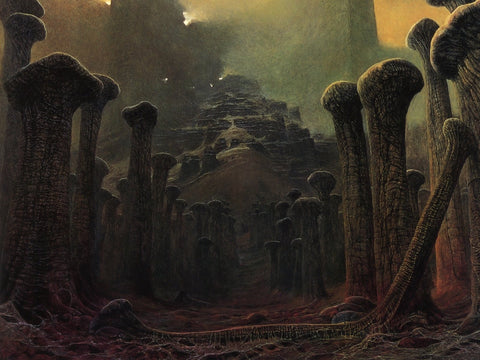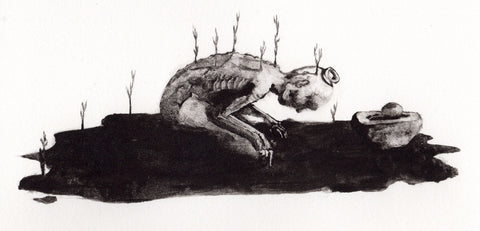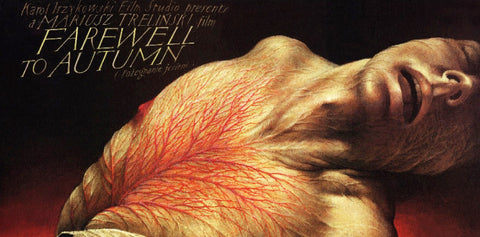
It's been years since we last had the chance to talk to Fred Grabosky, the Philadelphia-based artist and illustrator. As part of our latest collaboration, we caught up with him in his Fishtown studio to discuss art and music influence, scratch boarding vs. pen and ink, he touches on sacred geometry, spiritualism, and even feminism.
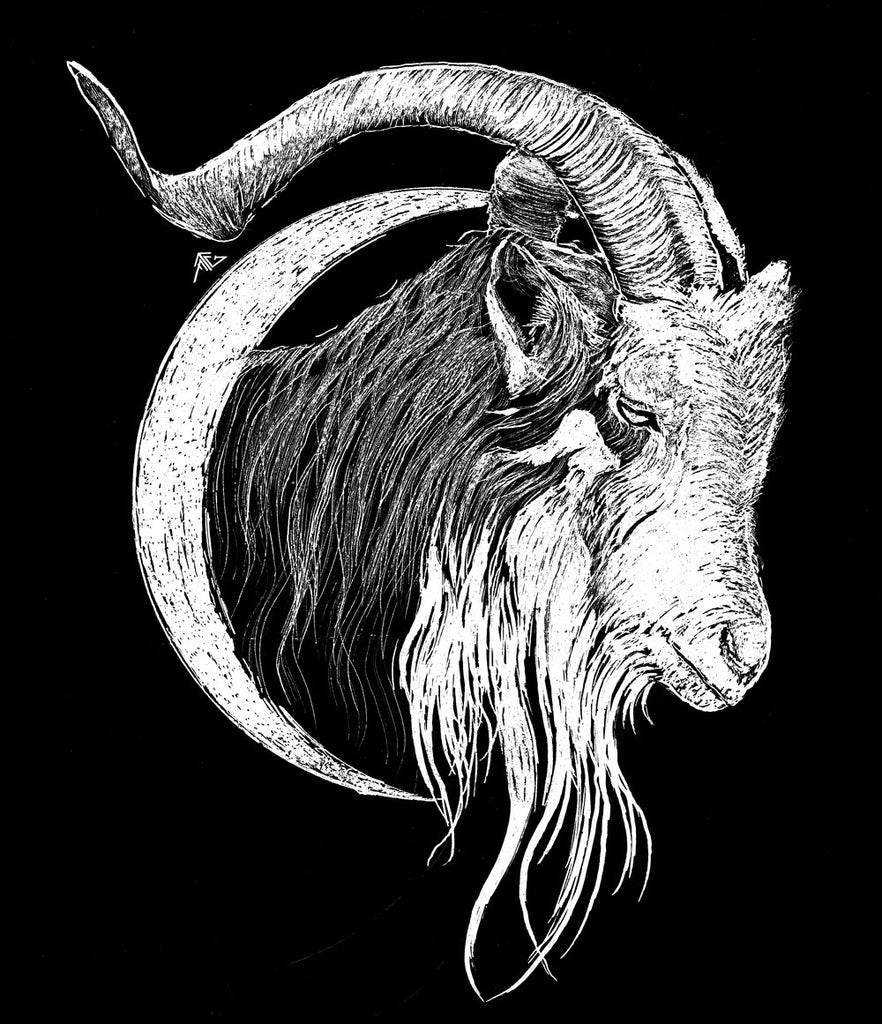
Goat Moon, prints available in the Dark Art & Craft store.
Are you a native of Philly?
Fred Gabosky: I moved to Philly from South Jersey when I was around 18 for school at University of The Arts. I’ve lived in the area South and West and North, here and there over the years, and up to now, so Philly seems like home base.
Philadelphia is one of America's oldest cities and it has a somewhat gothic and macabre history. Has that influenced your work at all?
FG: I’m sure it has influenced the art around me, and that in turn has influenced my artwork. There is a lot of enthusiasm for dark art out here. I’m just a walk down the street from The Convent gallery, where dark art really gets the praise it deserves. I've always loved Jeremy Hush and Paul Romano’s work, so it's cool to be a part of their gallery especially. I love to exist in the community they’ve built up over the years. Arch Enemy Arts, Grindcore House, and Paradigm Gallery, to name a few, have been housing some incredible artists as well. I hope to be a part of it all. There's been a really good metal scene out here for years now and metal thrives off of the darkness and the macabre. I'm very influenced by metal music in particular.

Emanating Death, prints available in the Fred Grabosky Dark Art & Craft store.
Did music lead you to art, or was it vice versa?
FG: Heavy music is a huge part of why I make this kind of art, though I had always enjoyed drawing and creating things. As a late teen, I had taken notice of punk album art, and it bridged the gap to metal, and then I just started to study who all these different artists were and where they came from.
Which album covers do you really love?
FG: One album cover that was a huge influence on me, though I sound young to say this, was Baroness' Red Album, it just made me really excited to think about what I could do with ink and color if I started to take it seriously. I was also listening to Kylesa around then and diving into that Southern sludge metal, which was a gateway to so much else. Seeing John Baizley’s work on those covers made a connection because I found out about his influence from Pushead and Mucha, and Pushead was influenced by Virgil Finlay- a sci-fi pulp magazine scratchboard artist from the '20s. It opened up a new world of art appreciation and that was a good jumping off point for me.

Decay is a Womb, prints available in the Dark Art & Craft store
Can you tell us about Decay is a Womb and the inspiration behind it?
FG: Yeah, I started making that piece because of my fascination with the parasitic fungus (Ophiocordyceps). It's a whole cycle; it takes over the brain of specific insects, tells them where to go, eats away at it, spores new life, and that new life takes over and repeats the cycle.
I related it to things that happen to me, not necessarily other people trying to control you, but how depression can become a controlling force in your life. There is a lot of fear and insecurity that can start to eat away at you. I’m currently creating a body of work on the subject, which will have a solo show in July here in Philly [Details below]. It also ties into what I'm doing with my band God Root. We're currently writing an album around the premise. We're also doing a split with some other bands and our track is called “Decay is a Womb.” I'm really fixated on this theme right now. It’s tying into my art as a whole.
What are some of your favorite art supplies that you use and recommend?
FG: Definitely Ampersand, they're the scratchboard brand that I use. I’m also always using the PIGMA Sakura brand Micron pens. My friend out in South Carolina, Chelsea Owen who works at Indigo Rose (@DarkHeartTattoo), showed me Canson Mixed Media paper and I've been swearing by it for three or four years now. You can sketch and/or ink finished pieces on it. I love Speedball brand inks for poster printing. Their metallic gold and silver are my life blood. I can’t forget French Paper Company. They have the market cornered. Quality paper products at affordable prices.

Fatal Beauty, now available in the Dark Art & Craft store.
Is your process very regimented or do you just work when the inspiration strikes?
FG: Back when I was doing more ink, it was whenever I had the time to get tedious and problem solve throughout a piece. It really became a process because you start to devalue what you are doing and beat yourself up for not working harder. The process has changed since I started doing scratchboard. Now I just sit the fuck down and say I'm going to make something and it is going to be great.
With ink, you never know when to stop. If you want a black background on white paper, you have to plan out all the weird techniques to make that background black. You could scan it in and make the outline, but that can look cartoonish and cheesy. You could go all around the perimeter making dissipating black dots, but that takes an incredible amount of time and it's a huge process for something that might not turn out right. With scratchboard, I'm starting with a black background and I'm making white lines and that’s it. It leaves less room for worry about composition issues.
Is scratchboard your preferred medium?
FG: Right now, it really is. Scratchboard has made a huge difference in my turnaround time too. When it was ink, it could take months to complete a piece because you have to know for sure where you want to make every line and every dot. Scratchboard is more my style. It’s more of a punk rock way of doing things. You just go for it and when you feel like it’s done, it's done. I also don’t see a lot of artists doing it like I do, so that’s appealing.

Cascading Romance, prints available in the Dark Art & Craft store.
With a more time-consuming medium like ink, did you ever run out of inspiration before you could finish the piece?
FG: Sometimes I would really just hit a wall. There are a lot of ink artists out there in the dark art scene and I don't want to do the same thing everyone else does. It was a good starting point because a lot of ink artists inspired me, but I'm doing something different. I can embrace scratchboard and translate it in weird ways, maybe even somehow on stained glass.
The last time we talked, you were working in a stained glass studio. Do you still work there?
FG: Yes, I probably just started that job when I did the first interview with you guys. I've been there for almost three years now and I really dig it. It's a very unique gig. I get to work with beautiful pieces from the 1800s and 1900s. There are not many that can say they’ve worked with stained glass either. Our business is also prestigious because there aren’t many studios who can say they have on-site painters, for one thing. I feel pretty fortunate to have fallen into the field.
Do you work with a lot of iconography or religious stained glass?
FG: Yes, mostly actually. I don't have any religious ties myself, but I appreciate the art for what it is. Some of it has had a bit of an influence on my work, and I’m looking to push that soon, but I’m trying not to do things that have been done a million times.
You mean that ironic mix of Judeo-Christian images and Pagan themes?
FG: I guess, yeah. There are a lot of artists who do renditions of religious art and make it grim or evil or Satanic. It’s cool, but I don’t need to add to that pile much. I want to stand out.
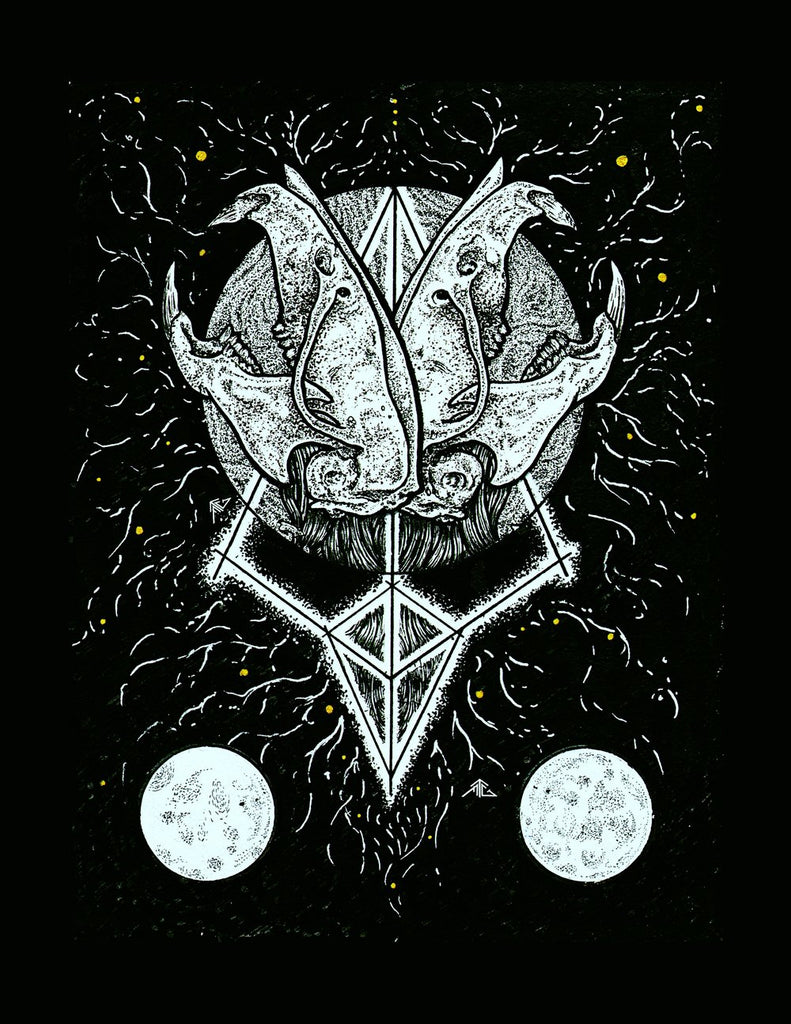
Symmetry in Death, prints available in the Dark Art & Craft store.
So you aren’t really religious, but do you consider yourself to be a spiritual person? It seems to show in some of your work, especially your “Sacred Geometry in Symbolism Series.”
FG: I would definitely say I am spiritual in a sense. I studied into eastern philosophy and religion and found ties to sacred geometry in their symbols for that project, yes. I’m fascinated that the universe as whole shares a connective tissue with mathematics. Cosmic nature and its sacred geometry are the closest thing I can hold to a higher power. It's fascinating that you can find SG in everything, from microscopic energy of life, to occult and religious symbols, to logos we see every day, to the trees and flowers and the skulls of our corpses. It’s everywhere. I believe that nature on earth is one with all life in the universe and all life shares energy in sacred geometry throughout the cosmos.
We've talked a bit about the artists that you look up to. How would you define artistic success?
FG: There are a lot of artists that I could look at as an example of success, but if you asked them, they would probably say that they've had successes in the past, but don't consider themselves to be a complete success. That’s what an artist is though. We are our own worst enemies and we beat ourselves up about our work, but its a slow climb for some more than others to feel like a success in any caliber. You have to make sure that you aren't comparing your success to other artists’ success all the time, because everyone has their own story. Little triumphs are something that should be appreciated more. I’ve learned you have to show some self-love and be happy with what you've accomplished every step of the way, and just keep making shit.
Do you think social media has made it easier to share and celebrate those little triumphs? Or are people crippled by constantly comparing themselves to other artists?
FG: It's hard to feel like you can be successful without integrating social media into your process. There's just so much content flooding the internet now. It feels like you have to fight for space with other artists who are trying to make a name for themselves sometimes. It's daunting, but that’s not what should be happening. Even as I sit here feeling good about what I just said, in the back of my head I hear those fears and insecurities, "You know you don't really think that because everyone wants that big online following." But that's just me comparing myself to other artists. It's very overwhelming if you don't know how to put the phone down once in a while and tell yourself to just keep making your art. Keep going. People are always going to be crushing it out there. There will always be someone “better” or more popular than you. You just have to use it as inspiration to push yourself forward. Your story might be very different. Focus on your art and your happiness doing it.
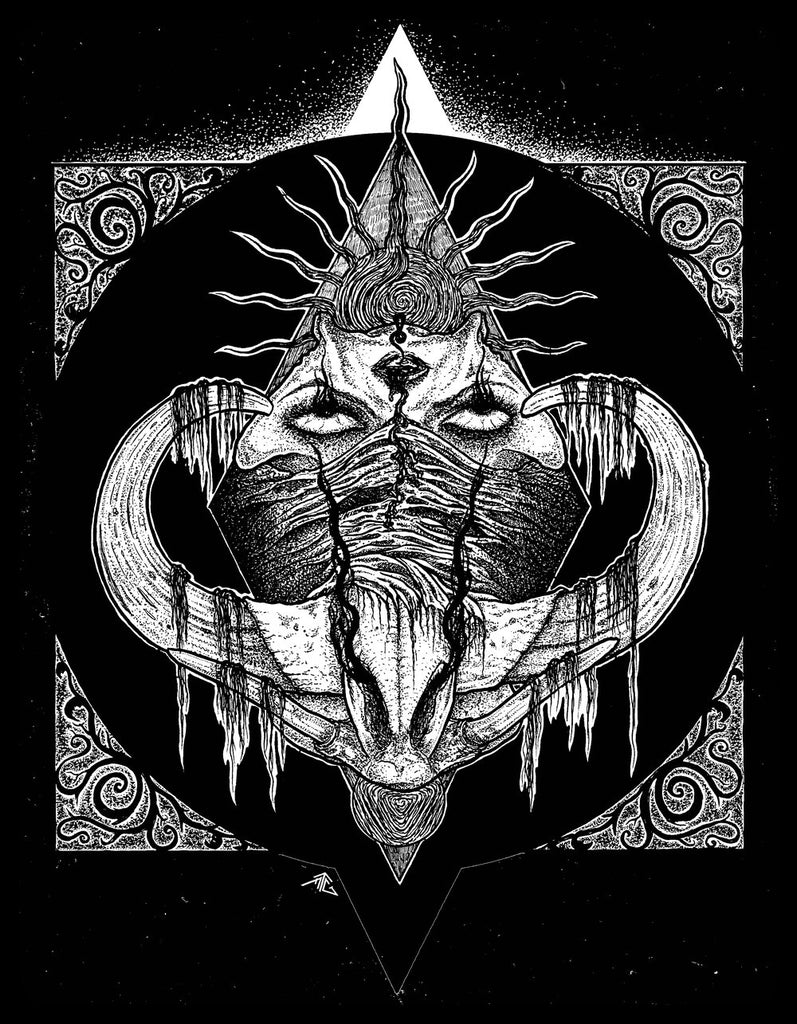
Strength and Divinity, now available in the Dark Art & Craft store.
Speaking of online perils, you've spoken very passionately about the struggle women face and how that inspired Strength and Divinity. Would you consider this to be a feminist piece?
FG: I'll admit that this piece was originally created just as a commission for a sweet Midnight Collective bill with Un, Hissing, and Teeth. I didn't plan it out and think, "I'm going to do a piece about my budding feminism and showcase the power of women." It just kind of came out the way it looks. But upon making it, I can’t help but feel like subconsciously, my head was thinking in that direction. Now I can say in retrospect, it feels right to think about the strength and fury of women through all of the injustices they’ve endured in that piece, but I can’t sell it or me as a feminist.
I actually wanted to put the word "FEMINIST" on the bottom of it at one point in the heat of the women’s rights rallies against Trump, and social media outings of assault toward women, but I put it out there to my friends and I had a lot of women say that the image and message could be misunderstood. It could come off like I’m speaking for women, and that takes their voice away. I also wasn’t trying to capitalize on something as serious as rights for my opposite sex for a profit. So, I decided not to put any text on it. It’s upsetting what women have to go through. It took me a while to understand why I didn't see it as clearly before. I think as a society, we adhere to these social norms brought on by ones our parents had, and their parents and so on. There are so many male power-hungry ideals set in place that have been out there since the dawn of time.
I think it's important to realize how much shit women deal with on a daily basis. Catcalling, or saying weird aggressive pickup lines, or touching women when they don't want to be touched isn’t okay. I feel like I could speak for a lot of men when I say that we didn't even realize it wasn’t okay. That sucks. It sucks that it took this long for men to realize it, and women don't even mention it half the time. It’s fucked up.
I think that's pretty accurate. It's easy to address overt sexism because it's more objective, most people can agree that it's wrong even if it does have to be shoved in their face first. It's the subtle things that aren't so easy to address because, you're right, women are told that they're misinterpreting what happened or exaggerating or just making it up.
FG: That sucks.
Yes it does, and the process you described earlier is how a lot of artists work. I think most artists work at a subconscious level and it's only in hindsight that you're able to reflect on how it was representative of where you were at that time.
FG: I hear you there, but I guess I wouldn’t want anyone thinking I was using my work for something false. I think it certainly depicts a woman’s struggle of being heard/ being censored, while also depicting her power. I will always find a way to depict power and energy in my work, as well as life and death in nature, and the connectivity humans share with it.
I’m already thinking about how I could have worded this better.
You'll drive yourself nuts doing that.
FG: I drive myself nuts everyday.
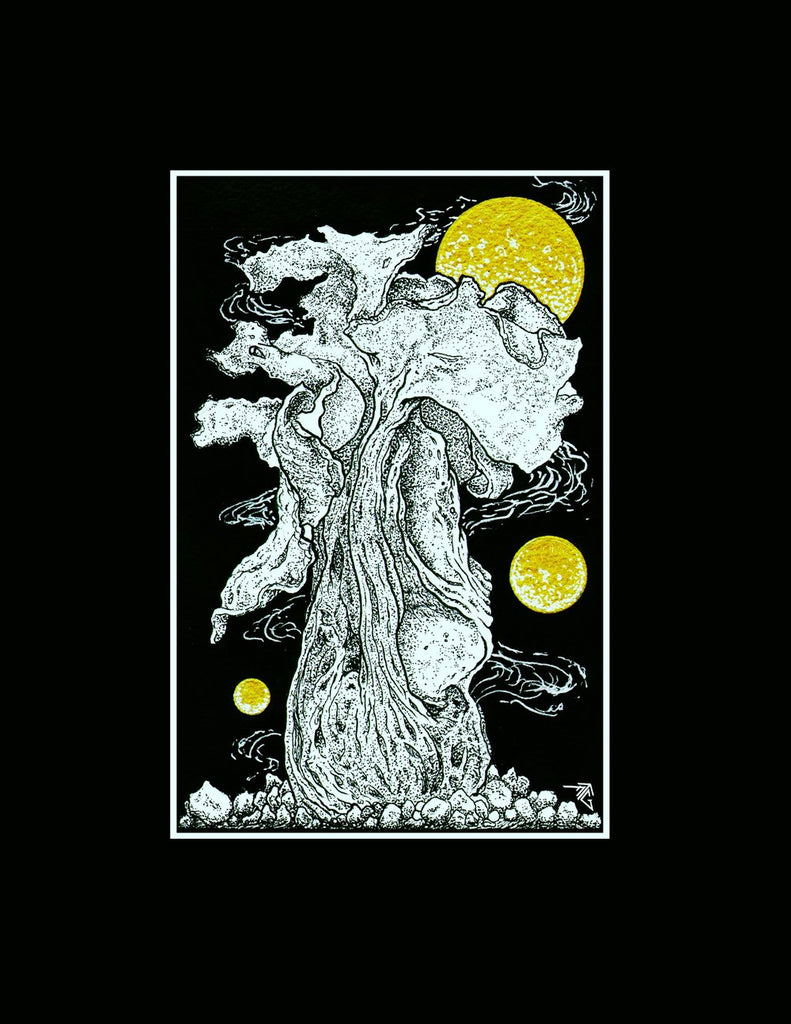
Cosmic Growth, prints available in the Dark Art & Craft store.
You can find limited edition prints of Fred Grabosky's work in the Dark Art & Craft store.
For more of Fred's work, visit his website and follow him on Instagram.
Events and Exhibits:
07/13 - Grindcore House in Philadelphia, PA. This solo show will run for two months.
07/14 - Gristle Tattoo and Art Gallery in Brooklyn, N.Y. “Phobos & Deimos” group exhibition.
09/13-15 - Vending Shadow Woods Metal Fest -Whitehall, MD.
(God Root will be performing Friday 09/14)
10/04-11/2 - Portside Parlor in Phila, PA. Solo show open, month-long Autumn-themed exhibit
10/20 FTG vending at Street Metal Massacre Festival Philly, PA


